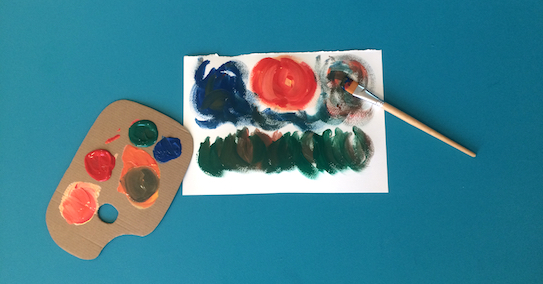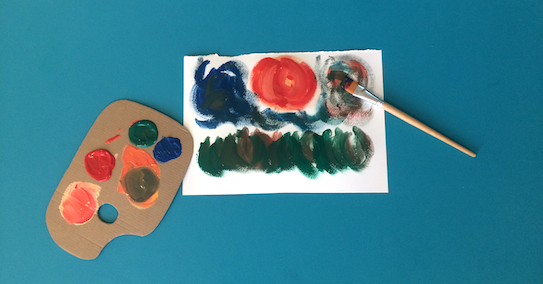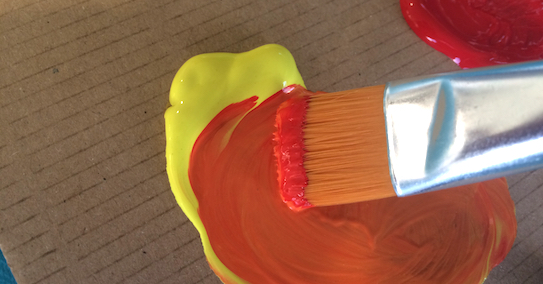Cardboard Artist’s Palette

Painting is the most fun when you’re going a little bit crazy with colour, and experimenting! And there’s a lot to learn when you start to mix primary colours together to get different outcomes. We’re not going to tell you the big secrets of colour mixing - it’s way more fun for you to discover yourself. Instead we’ve come up with a very quick and easy cardboard artist’s palette that you can make at home to begin your painting odyssey. Plus, to get a little inspiration, we’ve added a few facts about some of our favourite artists, and some quick tips on how they painted.
Try toucanBox free Visit our shop
Paint Like The Greats
Learn a little bit about the styles of some of the greatest artists, and use it to influence your paintings. We’ve picked a few artists to give you some inspiration from the masters.
Pablo Picasso
Between 1907-1909, Picasso and a French artist called Georges Braque created a movement known as cubism. They painted in cubes or blocks, resulting in quite abstract paintings of people or still life. They would play about with angles, so you might see a painting that combined a front-facing and profile view of a subject. Picasso had lots of different painting styles, but many of his paintings had an abstract quality to them.
To paint like Picasso, try painting someone using squares and cubes. Don’t worry about where you place key features: try putting the subject’s nose in a different place, or making their eyes different sizes.
Did you know: Young Pablo shortened his name from the less-than-catchy Pablo Diego José Francisco de Paula Juan Nepomuceno María de los Remedios Cipriano de la Santísima Trinidad Martyr Patricio Clito Ruíz y Picasso to just Pablo Picasso. It still stands as a smart choice.
Claude Monet
Monet was known for his impressionist paintings. When he painted he wanted to capture movement and changing light and colour. He wasn’t focussed on his paintings looking real - instead his paintings tried to reflect how people looked at a landscape.
So how do you paint like Monet? You go outside! Grab your painter’s materials and go out into the garden, or a forest, or a park. Find a scene that you like the look of. Why do you like it? What colours do you see? How does it make you feel? Then get painting!
It’s also important with impressionist paintings that you paint quickly, so the light doesn’t change too much. Focus less on the finer details and more on getting the scene on your canvas!
Vincent Van Gogh
Ah, Vincent. One of the greatest artists that ever lived, Van Gogh didn’t get the credit he deserved when he was alive. He painted his first work when he was 27, and only sold one painting before he died.
But his paintings are staggeringly beautiful. He would mostly paint still life or landscapes (he was too poor to pay models), but instead of capturing them with realism, he would use heavy swirls of colour to bring his subjects to life. He was also part of the impressionist movement, but unlike Monet, his work was more fantastical.
To recreate some of Van Gogh’s spark, try painting with a thick paint. Put a lot on your brush, and instead of painting in straight lines, try painting in circles and curved motions. Experiment with layering colour on top of colour, creating something bright and confident.

Frida Kahlo
Frida Kahlo was one of the greatest painters to emerge from Mexico in the first half of the 20th century. Her main subject of her paintings was… herself! She specialised in self-portraits, using different styles to capture feeling and emotion. Her portraits didn’t just show her, it showed much more. During the 1930s her paintings took on a more surrealist nature, and would reflect her feelings, or hardships that she went through.
To paint like Frida, use yourself as your subject. You could get a mirror and use that to begin your painting, or you could create a self-portrait from memory. What other elements would you like to show? How would you show in the painting your favourite things to do, or the things that make you happy? Add details to tell more of a story.
Make your own artist’s palette
You Will Need
- Some cardboard (A5 will be perfect)
- A pencil
- Paint
- Cupcake liners (optional)
- Glue
- A paintbrush
- Scissors
What to do
1 On your A5 piece of cardboard, draw a curve around each corner. Cut them out so you’re left with a palette with a curved edge.
2 In one corner draw another curve to make an oval shape. Draw a circle next to it. This will be your thumb hole, so make sure it’s big enough to comfortably get your thumb through. Cut these bits out.
3 You can add some cupcake liners to make little paint pots. Add glue to the bottom of each one and stick on.
4 Add paint to your palette! For paint you don’t want to mix, drop it in the cupcake liners. If you want to experiment with mixing paint, place them straight on the palette in little dollops.
5 Pick up your paintbrush with your writing hand. With your other hand, place your thumb through the hole in the palette. Mix the colours on your palette, and add them to your canvas.

Share your creations with us
…And the world. We’d love to see your crafty masterpieces. Share them on Facebook, Instagram, Pinterest and Twitter. Add #toucanBox.
